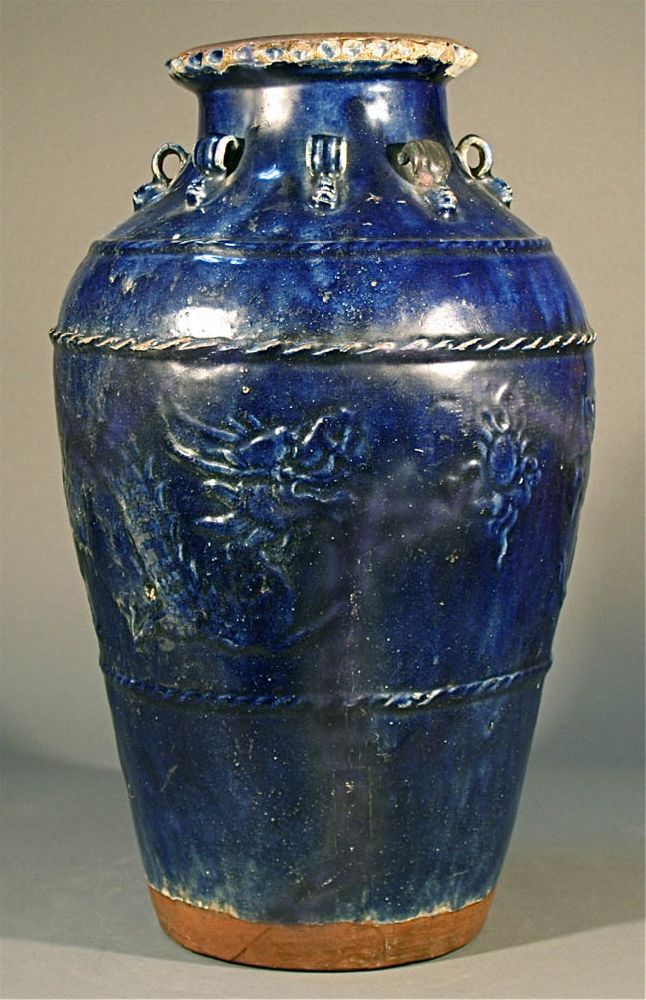

Title: Large blue glazed Chinese pottery ceramic clay storage jar vase
Shipping: $200.00
Artist: N/A
Period: 18th Century
History: N/A
Origin: Central Asia > China
Condition: Excellent
Item Date: 1644-1912
Item ID: 3394
Beautiful blue glazed storage jar with 8 earlets. This amazing piece from China also has a rope and dragon embellishing the perimeter. It is estimated to be Qing dynasty and has been restored. Today, the market of Chinese art is widely reported to be among the hottest and fastest-growing in the world, attracting buyers all over the world. The Voice of America reported in 2006 that Chinese art is raking in record prices both internationally and in domestic markets. Sotheby's noted that Chinese art has rapidly changed the Asian art world into one of the most dynamic sectors on the international art market.
Link: http://en.wikipedia.org/wiki/Chinese_art
The Qing Dynasty (Chinese: 清朝; pinyin: Qīng Cháo; Wade-Giles: Ch'ing ch'ao; IPA: [t͡ɕʰíŋ t͡ʂʰɑ̌ʊ̯]; Manchu: Daicing gurun.png, Von Möllendorff: Daicing gurun), also known as the Manchu Dynasty, was the last ruling dynasty of China, ruling from 1644 to 1912 (with a brief, abortive restoration in 1917). It was preceded by the Ming Dynasty and followed by the Republic of China.
The dynasty was founded by the Manchu clan Aisin Gioro in what is today northeast China (also known as Manchuria). Starting in 1644 it expanded into China proper and its surrounding territories, establishing the Empire of the Great Qing (simplified Chinese: 大清国; traditional Chinese: 大清國; pinyin: Dà Qīng Guó; Wade-Giles: Ta Ch'ing Kuo, or simplified Chinese: 大清帝国; traditional Chinese: 大清帝國; pinyin: Dà Qīng Dì Guó; Wade-Giles: Ta Ch'ing Ti Kuo). Complete pacification of China was accomplished around 1683 under the Kangxi Emperor.
Originally established as the Later Jin Dynasty (simplified Chinese: 后金; traditional Chinese: 後金; pinyin: hòu jīn) Amaga Aisin Gurun (Amaga aisin gurun1.png) in 1616, it changed its name to "Qing", meaning "clear" or "pellucid" in 1636. In 1644 Beijing was sacked by a coalition of rebel forces led by Li Zicheng, a minor Ming official turned leader of the peasant revolt. The last Ming Emperor Chongzhen committed suicide when the city fell, marking the official end of the dynasty. The Manchus then allied with Ming Dynasty general Wu Sangui and seized control of Beijing and overthrew Li's short-lived Shun Dynasty.
During its reign the Qing Dynasty became highly integrated with Chinese culture. The dynasty reached its height in the 18th century, during which both territory and population were increased. However, its military power weakened hereafter and faced with massive rebellions and defeats in wars, the Qing Dynasty declined after the mid-19th century. The Qing Dynasty was overthrown following the Xinhai Revolution, when the Empress Dowager Longyu abdicated on behalf of the last emperor, Puyi, on February 12, 1912.
Chinese art (Chinese: has varied throughout its ancient history, divided into periods by the ruling dynasties of China and changing technology. Different forms of art have been influenced by great philosophers, teachers, religious figures and even political leaders. Chinese art encompasses fine arts and folk arts. Early forms of art in China were made from pottery and jade in the Neolithic period, to which was added bronze in the Shang Dynasty. The Shang are most remembered for their blue casting, noted for its clarity of detail.In early imperial China, porcelain was introduced and was refined to the point that in English the word china has become synonymous with high-quality porcelain. Around the 1st century AD, Buddhism arrived in China, though it did not become popular until the 4th century. At this point, Chinese Buddhist art began to flourish, a process which continued through the 20th century. It was during the period of Imperial China that calligraphy and painting became highly appreciated arts in court circles, with a great deal of work done on silk until well after the invention of paper. Buddhist architecture and sculpture thrived in the Sui and Tang dynasty. Of which, the Tang Dynasty was particularly open to foreign influence. Buddhist sculpture returned to a classical form, inspired by Indian art of the Gupta period. Towards the late Tang dynasty, all foreign religions were outlawed to support Taoism. In the Song dynasty, paintings of more subtle expression of landscapes appeared, with blurred outlines and mountain contours which conveyed distance through an impressionistic treatment of natural phenomena. It was during this period that in painting, emphasis was placed on spiritual rather than emotional elements, as in the previous period. In the Yuan dynasty, painting by the Chinese painter Zhao Mengfu (趙孟頫) greatly influenced later Chinese landscape painting. Under efforts of masters from the Shanghai School during the late Qing Dynasty, traditional Chinese art reached another climax and continued to the present in forms of the "Chinese painting" (guohua, 國畫). The Shanghai School challenged and broke the literati tradition of Chinese art, while also paying technical homage to the ancient masters and improving on existing traditional techniques.